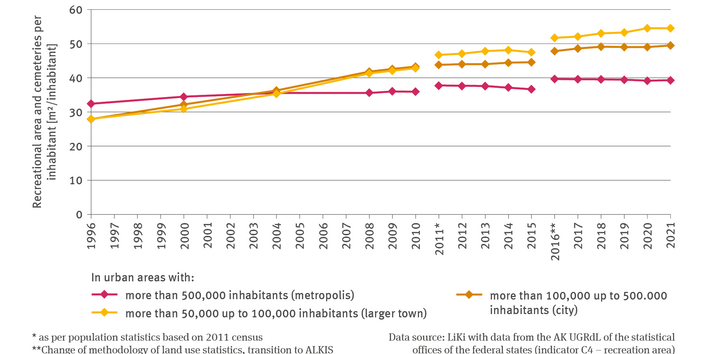Exposure to thermal stress can cause health problems in the population and, in extreme cases, can increase mortality figures. Categories at risk are primarily older people, people with chronic illnesses, children and people who live in isolation. However, other population categories can also be affected by the more frequent heat stress expected to occur in the future (cf. Indicators GE-I-1, GE-I-3). Heat stress is also and in particular, caused by high nocturnal temperatures which prevent or hamper a good night’s rest (cf. Indicator BAU-I-1). Moreover, impacts on the economy can be caused by staff suffering from fatigue, impaired concentration and stress on the cardio-vascular system, making them less productive when temperatures at their workplace are too high (cf. Indicator IG-I-1).
It is expected that climate change will further intensify urban climate effects (cf. Indicator BAU-I-2), potentially leading to an increased incidence of heat-related health problems. Measures can be taken at various levels to counteract or pre-empt such impacts resulting from climate change. The appropriate design of urban spaces and residential areas can make important contributions to curb such impacts, by ensuring – both in terms of quantity and quality – the provision of ‘green’ and ‘blue’ infrastructures, i.e. with public and private green spaces and water bodies. Mostly green, sparsely sealed terrain such as recreation areas dedicated to sports and games, park-like areas and campsites or even cemeteries, fulfil important functions in localised micro-climates, especially in cases where they are inter-connected.
The positive effect of green spaces on the urban climate and air quality as well as noise abatement depends on the size, structure and composition of areas enhanced by vegetation. Compared to the built environment, even areas just covered in grass achieve positive changes in terms of radiative and heat regimes, provided there is ample provision of water. Shrubs and vigorous, shade-giving trees with a high crown reinforce the positive bio-climatic effects, at the same time as increasing an individual’s thermal comfort. Compared to the built environment, lower surface and air temperatures can develop. In addition, green spaces, especially those containing trees have greater relative air humidity than sealed areas. For plants and trees to develop their full potential, they depend on sufficient root space and a good water supply.
As far as Germany’s towns with population sizes in excess of 50,000 inhabitants are concerned, the public recreation areas are on average greater in smaller towns whereas larger towns tend to offer less space for recreation. The current provision of recreation areas in metropoles with population sizes of more than 500,000 is actually the smallest. The larger medium-sized towns with population sizes between 50,000 and 100,000 currently enjoy, quantitatively speaking, the best provision of recreation areas.
The temporal development of recreation area per inhabitant is difficult to interpret. Reasons for this are to be found in changes regarding the assignment and valuation of land which were adjusted when the Authoritative Real Estate Cadastre Information System (ALKIS) was first introduced in 2015. This process has led to changes in land use statistics which were not based on actual changes of use. Especially in 2000 and 2008 some Federal States (Länder) carried out massive reassignments which have had significant impacts on the data series. Nevertheless, the data series for the years of 2011 to 2015 shows that the extent of provision of recreation areas in the metropoles and larger medium-sized towns was ultimately in decline. Since 2016 the provision in cities and metropoles with population figures in excess of 100,000 has remained largely the same, while the degree of provision in medium-sized towns has improved. It has proved impossible to arrive at a detailed identification of the reasons for these developments on the basis of data underlying this indicator.
In principle, municipalities with specific responsibility for the settlement’s climate are able to exert a positive influence on the development, for instance by maintaining existing green spaces, by networking them, and by creating additional green spaces. Ideally the green spaces should be connected by fresh-air corridors to areas such as meadows and fields in the rural environment where cold air is produced. This way, municipalities enhance the ecological functions of residential areas thereby increasing the area’s quality of life and housing quality. In view of the currently prevailing drive for housing development, municipalities face particular challenges to their endeavour to create sufficiently large green spaces for the population thus counteracting the densification of built-up areas. Especially in metropoles it is of vital importance to keep an eye on and control these developments in order to prevent this type of growth from occurring at the expense of the urban climate thus affecting the local quality of life.


